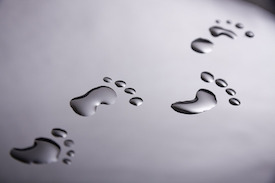The things that most people think of when reducing water use are often domestic uses like sprinklers, showers, and toilets. However, the water hidden in the food we eat and the products we use make up a much larger portion of our total water consumption. Although we will always have plenty of water on Earth, the amount of usable freshwater that is easily accessible will continue to decline. This article suggests four ways that you can reduce your water footprint.

Electricity generation from thermoelectric power generation rivals agriculture as the largest consumer of water in the United States. The latest numbers from US Geological Survey from 2005 show that freshwater withdrawals for thermoelectric power equates to 143 billion gallons per day or about 41% of US freshwater withdrawals. The water is used to cool the power plant and water is needed to cool 90% of the power plants in the United States. Lighting a 100 watt lightbulb for 10 hours will consume one kilowatt‐hour (kWh) which may require 20-60 gallons of water by a coal or nuclear power plant to produce. Some of the largest consumers of electricity in the home include refrigerators, water heaters, central air conditioning, and home heating systems. The world energy demands will continue to grow which will put a strain on local fresh water supplies. By the year 2040, it is predicted that there will not be enough freshwater resources to meet world demand for both drinking water and energy production. Solar and wind energy do not require water for cooling so switching to solar or wind energy will significantly reduce water use.
Learn About the Water Footprint of Foods
Waterfootprint.org provides figures for the global average water footprint of different food products. For example, the global average water footprint for beef is 1849 gallons per pound while pasta has a water footprint of 219 gallons per pound. Therefore choosing pasta instead of a burger will have a smaller footprint. Almonds and walnuts are some of the most water intensive foods, requiring an estimated 2,126 and 1,226 gallons per pound respectively. Vegetables and fruits tend to have a lower footprint than meat products. Oranges have a water footprint of 67 gallons per pound, cucumbers have a water footprint of 42 gallons per pound, and cabbage have a water footprint of 28 gallons per pound. Drinks also have a water footprint of 1.39 liters per liter of bottled water, 2.02 liters per liter of soda, 4 liters per liter of beer, and 4.74 liters per liter of wine. You can find the water impact of your food choices by viewing the product gallery at Waterfootprint.org.
Learn About the Water Footprint of Products
Water is required to manufacture all products and the amount can be significant. 500 sheets of paper requires 1321 gallons of water. A car requires an estimated 39,090 gallons while a pair of cotton jeans requires 1800 gallons. One ton of steel requires about 62,000 gallons of water while a ton of cement requires 1,360 gallons. It takes about 24 gallons of water to make one pound of plastic. Considering how much water can go into manufacturing a product and buying recycled goods can be a good way to reduce your water footprint.
Travel Less
Another way to reduce your water footprint is to limit travel by working from home or vacationing locally. Traveling requires gasoline or electricity which both require significant water resources. Refineries use about 1 to 2.5 gallons of water for every gallon of petroleum products which equates to about 1 to 2 billion gallons of water per day in the United States. The shale gas industry also expends significant water resources to produce oil with one estimate of 2 million gallons per frack job. Flying commercial airlines can cost thousands of gallons of water per flight. A 700 mile round-trip flight from Los Angeles to San Francisco takes about 9,000 gallons of water.
